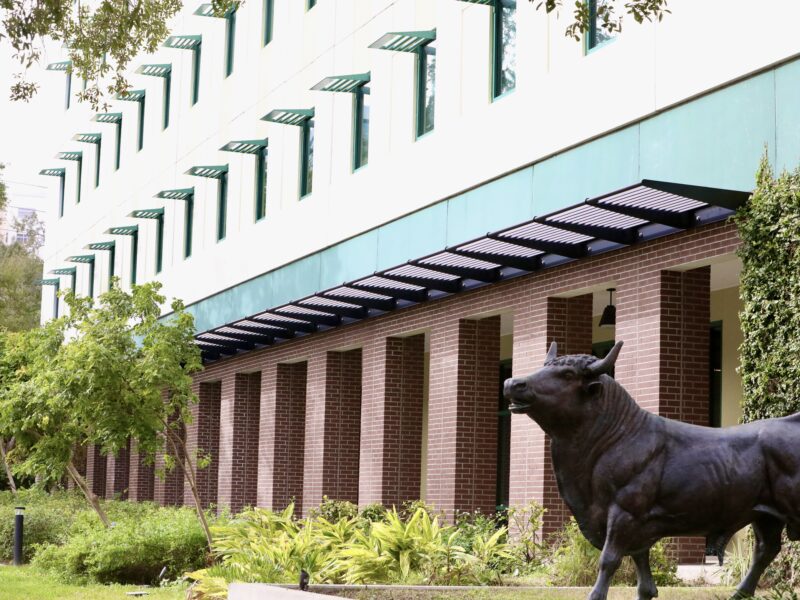St. Petersburg is making waves again, and this time, the current is felt all around the world. The city hosted the Blue Ocean Film Festival and climate summit. The conference, which ran from Nov. 3-9, aimed to educate the general public about the issues facing the ocean, and served as an industry conference to collaborate on improving the future of the ocean, as well as to honor the best in ocean filmmaking. This was accomplished by promoting critical dialog between filmmakers and scientists to inspire great films, and connecting ocean filmmakers with the latest technology.
Among the high-profile speaker lineups were Don Walsh, Fabien Cousteau, Sir Richard Branson, Jeremy Irons and Sir Robert Swan. There were numerous exhibits and workshops for attended to experience as well. Many of them were hands on, such as Robert Ballard’s E/V Nautilus, and a field trip to Egmont Key.
BLUE kicked off on Nov. 2 with a community cleanup on Spa Beach. During the seven-day conference, dozens of speakers educated guests on their careers, adventures and efforts to preserve the oceans.
One of the major components of the conference was the film festival, which was hosted at various locations around the city. Award-winning filmmakers and documentarians created films with topics ranging from undersea biodiversity to World War II era munitions dumping. As of this printing, the awards ceremony for the films will occur Sunday night.
Multiple industry events aimed to provide networking opportunities for scientists, filmmakers and educators. New technologies were unveiled at the conference, such as the latest Exosuit and underwater photography equipment.
BLUE celebrated its first year in the Sunshine City in 2014. The festival relocated here from Monterey California, where it outgrew its previous venue. BLUE returns to St. Petersburg every four years, sharing the festival with the Principality of Monaco, on the French Riveria.
Among the exhibits that attendees could experience were Robert Ballard’s research vessel, the R/V Nautilus. Ballard, who is famous for discovering the wreck of the Titanic in 1985, and his crew spend four to five months each summer researching various aspects of the deep ocean. The team utilizes four ROVs – Remotely Operated Vehicles – to explore, map, and collect samples of the ocean floor.
Numerous high-profile individuals spoke at the conference. Filmmakers discussed their inspiration and methods for their films, photographers told stories of their expeditions through the Florida swampland, and scientists discussed the latest discoveries on the ocean floor.
However, what I found most fascinating were the lectures given by Sir Robert Swan and Dr. Don Walsh. Swan was the first individual to walk to each one of Earth’s poles. Each year, he takes a handful of students from around the world to Antarctica or research and awareness. Combining British wit with a fascinating tale, Swan inspired the audience with adventures and hardships on his polar explorations.
Dr. Don Walsh, along with Dr. Jacques Piccard, became the first man to reach the deepest part of the ocean, Challenger Deep in the Marianas Trench, January 13, 1960. As part of the Navy’s Project Nekton, Lieutenant Walsh and Dr. Piccard piloted the bathyscaphe Trieste to a record-setting depth of 36,000 feet. The dive was not made for science, but rather to test the technology needed for manned operations at extreme depths for the U.S. Navy.
Saturday morning, Nov. 8, saw a wildlife expedition photograph and explore historic Egmont Key. Photographers put into practice techniques they had learned in lectures and workshops earlier in the week.
I noticed many interesting features about BLUE. First of all, every luncheon or after party that we attended did not have any meat on the menu; they were completely vegetarian. In a seemingly obvious decision, fish was excluded as well. This was yet another attention to detail that BLUE’s planners put into the event as a way to promote healthy, sustainable oceans. Additionally, no plastic items were located anywhere within any venue used by BLUE. Everything was eco-friendly or conservation minded.
When the festival returns to our city in 2018, BLUE is sure to make waves again. The impact it has had on the city and region is already being felt, and is sure to grow each year.


